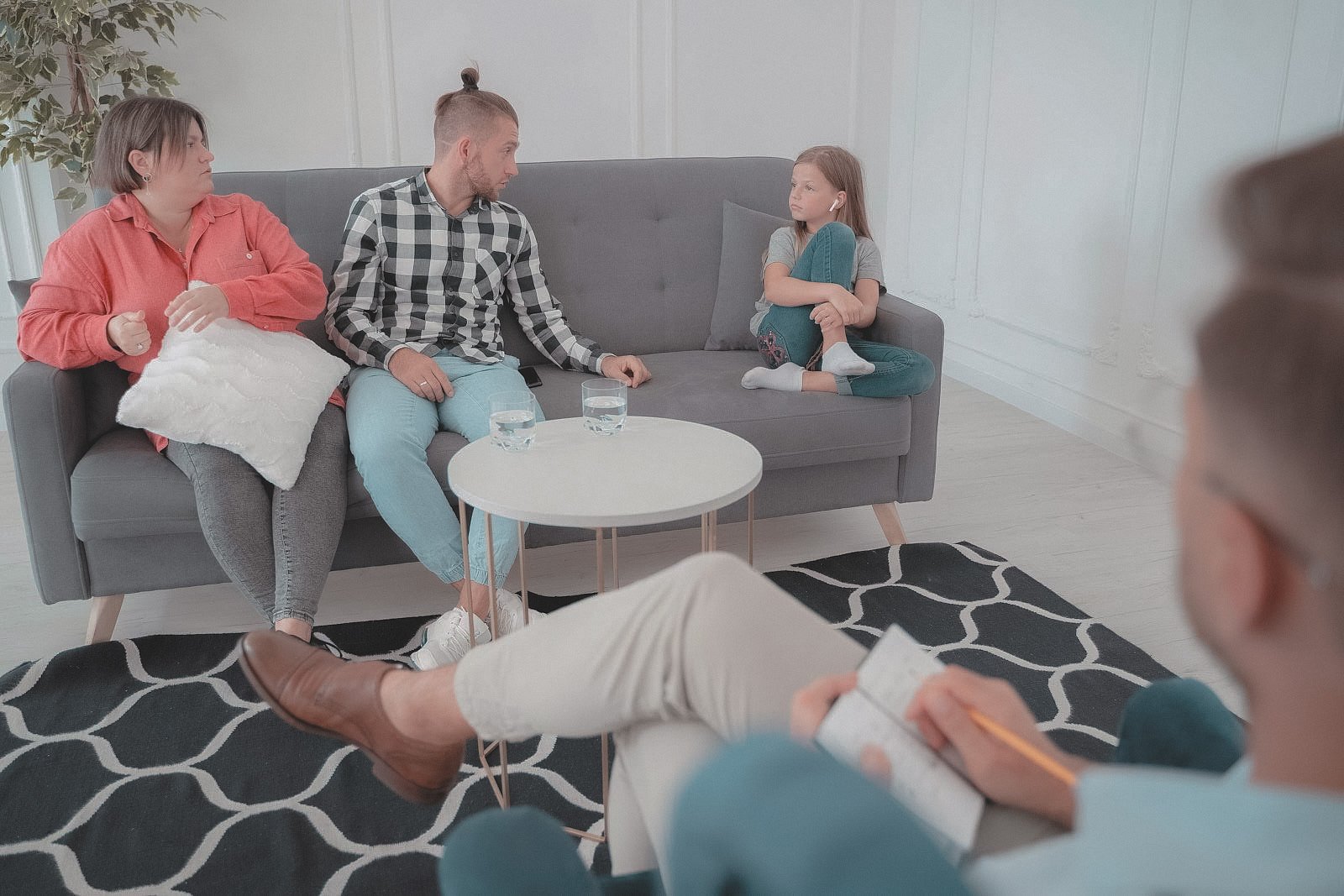Family Therapy vs Individual Therapy
Explore the key differences between family therapy and individual therapy. Find the best fit for your needs and improve your mental well-being.

Surveys show that parents worry most about one thing: their children’s mental health. Yet even with the best intentions, many aren’t sure how to help, especially when deciding between individual therapy to address a child’s personal struggles or family therapy to improve communication and strengthen family dynamics.
Individual and family therapy are distinct but complementary approaches, each with different goals and areas of focus. This guide explains what each offers, how they differ, and how to choose the right fit for your family.
Key takeaways
- The primary difference lies in focus: individual therapy addresses problems within a person’s inner world, while family therapy examines issues within the context of the entire family unit.
- Both approaches offer unique benefits and pose unique challenges, which is why it’s important to understand what each can (and can’t) do.
- The right choice depends on your needs, goals, and situation.
What are the key differences between family and individual therapy?
If you’re deciding between the two, it helps to understand where they diverge. Here are some key differences to help you make an informed decision.
Focus and goals
Individual therapy helps a person deal with internal issues, aiming to reduce symptoms and support personal growth. Family therapy examines relationships and interaction patterns, viewing difficulties as stemming from these dynamics.
Their goals differ as well: family therapy aims to change interaction patterns, communication styles, and relationship dynamics, while individual therapy focuses on building insight, developing coping skills, and promoting behavior change.
Confidentiality and privacy
Confidentiality is more complex in family therapy because multiple people are involved. Many therapists employ a “no secrets” policy to establish clear expectations, thereby preventing surprises that could harm trust or hinder progress. This means private information may be shared if needed for treatment.
Confidentiality is straightforward in individual sessions. What you share stays between you and your therapist (except in cases of imminent harm or legal requirements). This full privacy allows individuals to explore sensitive topics without fear of disclosure.
Duration and frequency
Family therapy is often brief and goal-oriented, averaging about nine therapy sessions, while individual therapy averages thirteen. However, the duration can be longer for both, depending on the goals, therapeutic approach, and the complexity of the issues. For instance, individuals with long-standing concerns may benefit from longer-term ongoing therapy.
Family sessions also run longer (60–90 minutes) to include multiple family members in in-session exercises and discussion of complex family dynamics, compared to 45–60 minutes for individual sessions.
The therapist’s role and engagement
Family therapists act as neutral facilitators to balance voices, reduce family conflicts, and rebuild trust, all while maintaining a neutral stance to avoid appearing to take sides.
In individual therapy, building a strong alliance is central. The one-to-one, confidential setting enables a deeper exploration and tailored treatment plan.
What is family therapy?

Family therapy, also called family counseling or systemic therapy, is a type of psychotherapy that looks at psychological struggles in the context of the family, rather than only within the individual.
It takes a systemic perspective, working from the idea that mental health challenges both affect and are affected by our relationships. Relationships are interconnected; each member’s behaviors and emotions can influence the entire family.
Unlike individual therapies that focus only on individual symptoms, family therapy works to shift the patterns, interactions, and narratives that perpetuate problems, while helping each person use their strengths to build healthier ways of functioning.
Common approaches in family therapy
Family therapists choose one model or blend several based on your family’s needs:
- Family-based therapy: The leading treatment for adolescents with eating disorders. Parents are empowered to take charge of their child’s recovery and are equipped with the skills and resources to help restore their child’s weight, normalize eating habits, and support healthy development.
- Functional family therapy: A short-term intervention for youth ages 11–18 with serious behavioral problems such as violence or substance use. It builds trust, teaches parenting skills, and connects families with resources to sustain progress.
- Multisystemic therapy: An intensive program for children and teens with persistent antisocial behavior. Therapists work with all the systems the child belongs to (e.g., family, school, peers) and collaborate closely with parents to strengthen parenting, improve communication, stay engaged in school, build supports, and limit contact with delinquent peers.
- Structural family therapy (SFT): Focuses on reorganizing family structure by clarifying boundaries and restoring healthy hierarchies. It strengthens the parental role, sets clear but flexible limits, and adjusts relationships as children grow.
- Narrative family therapy: Helps families reframe unhealthy family dynamics by deconstructing problem stories, separating problems from people, and creating new, empowering narratives.
What is individual therapy?

Individual therapy, also called psychotherapy or talk therapy, is a one-on-one process between a client and a licensed mental health professional. Its goal is to alleviate distress, enhance daily functioning, and improve quality of life through personal insight and behavioral change.
At its core is a private, collaborative relationship that provides a safe and confidential space for an individual to reflect, explore, and grow, working through concerns at their own pace.
Common approaches in individual therapy
Individual therapy draws from several evidence-based methods, depending on personal goals and needs:
- Cognitive behavioral therapy (CBT): Focuses on how thoughts, feelings, and behaviors are linked. Individuals learn to identify unhelpful patterns and develop coping strategies that, in turn, create healthier habits.
- Dialectical behavioral therapy (DBT): Combines CBT with mindfulness and acceptance strategies. DBT integrates acceptance with change, teaching distress tolerance and emotional regulation while building new coping skills.
- Psychodynamic therapy: Explores how unconscious thoughts and early life experiences shape current behavior. Therapists help clients build self-awareness and insight to encourage lasting change and growth.
- Person-centered therapy: Believes that people have an innate drive toward growth and are the experts of their own lives. Therapists take a supportive, non-directive role, giving individuals space for personal growth and finding their own solutions.
Benefits of family therapy vs individual therapy
Both family therapy and individual therapy come with unique advantages for kids and teens. Choosing the right approach comes down to your needs and goals.
Benefits of family therapy
It can help your family:
- Improve communication: Learn techniques like active listening and empathy to build understanding, strengthen cohesion, and resolve conflict more effectively.
- Enhance support network: Build confidence as parents or caregivers to support recovery, strengthen supportive relationships, and access community resources.
- Set boundaries and clarify roles: Set healthy boundaries among family members and adjust roles as children grow older.
Benefits of individual therapy
The private, focused setting of individual therapy brings several advantages:
- Personal growth: Explore thoughts, feelings, and history to build self-awareness and develop healthier habits.
- Confidentiality: Knowing your sessions are private encourages honest exploration, which is especially helpful for trauma, shame-based issues, or family secrets.
- Tailored interventions: Treatment is customized to your needs, allowing therapists to adjust approaches as you progress for more focused, effective results.
- Skill development: Research shows that individual therapy effectively builds long-term psychological resources, like coping skills and stress management.
Downsides and contraindications
While effective, both have unique challenges that may affect their effectiveness:
Challenges of family therapy
- Scheduling and logistics: Coordinating multiple members can delay progress.
- Unwilling participants: If key members refuse to attend or resist change, sessions may stall or worsen conflict.
- Power imbalances: One person may feel ganged up on or unheard without careful facilitation.
- Privacy concerns: Less confidentiality may deter members from sharing.
Family therapy is not recommended when:
- There is active domestic violence or abuse
- Someone needs stabilization first (e.g., active substance use, acute mental health crisis)
- Safety risks are high, including intimidation and threats
- Outside stressors (legal disputes, financial strain) dominate and require a specialized form of treatment
Challenges of individual therapy
- Systemic issues are driving the problem: Family conflict, addiction, or a child’s behavioral challenges often need family involvement to address root causes, rather than placing the full burden of change on one person.
- You need social practice: Individual therapy can’t provide shared experiences or real-time relationship practice that a session with your family can offer.
- Crisis or severe mental illness: Safety concerns, acute psychosis, or emergencies require coordinated care or crisis services. One-on-one sessions are not enough.
- Time and cost barriers: Long-term therapy can be expensive or difficult to maintain for ongoing conditions.
Evidence and effectiveness
Research consistently shows that both individual and family therapy can make a significant change in children’s and adolescents’ mental health.
- Meta-analyses show that 75% of children and young people who attend therapy benefit from it.
- Youth who received at least one session of family therapy were significantly more likely to stay in treatment programs an average of two weeks longer than those without it.
- Combining family therapy with individual therapy or group therapy has been linked to a 50% reduction in suicide attempts compared to using one alone.
- A meta-analysis found that 60% of children recover from anxiety disorders and experience notable symptom reduction after cognitive behavioral therapy.
- Across studies, dialectical behavior therapy reduced the number of adolescents engaging in self-harm behaviors.
How Emora Health can help
Family therapy focuses on improving family dynamics, while individual therapy concentrates on personal growth. The right path depends on your goals and the type of support that will help you the most right now.
Here at Emora Health, we’re here to help. We offer access to a wide network of vetted, trained therapists who specialize in youth mental health.
Whether you’re looking for individual therapy to support personal growth or family therapy to strengthen family relationships and create a supportive environment, Emora makes it easier to get started and find the right fit.
You can choose based on what matters most to you, from schedules and approaches to specialties.
Frequently Asked Questions
It depends. If someone has severe mental health issues, active substance use, or needs stabilization, individual therapy usually comes first. Once safety and stability are in place, family therapy can address relationship patterns and strengthen support.
The best type of therapy depends on what you’re facing. If you’re dealing with anxiety, depression, or OCD, CBT is often a great choice. For teens with eating disorders, FBT is considered the first-line treatment. For children and teens struggling with substance issues, or conduct, or oppositional defiant disorder, programs like FFT, MST, and MDFT can be very effective. Regardless of the approach you choose, a strong connection with your therapist and a supportive environment are essential for making progress.
Neither is inherently better; it depends on your goals. Family therapy addresses relationship dynamics, while individual therapy focuses on personal insight and symptoms. Many people benefit from using both together.
- About Marriage and Family Therapists. (n.d.). American Association for Marriage and Family Therapy. https://www.aamft.org/AAMFT/About_AAMFT/About_Marriage_and_Family_Therapists.aspx
- Berry, K. R., Gliske, K., Schmidt, C., Ballard, J., Killian, M., & Fenkel, C. (2023). The Impact of Family Therapy Participation on Youths and Young Adult Engagement and Retention in a Telehealth Intensive Outpatient Program: Quality Improvement Analysis. JMIR formative research, 7, e45305. https://doi.org/10.2196/45305
- Functional family therapy. (n.d.). National Gang Center. https://nationalgangcenter.ojp.gov/spt/Programs/64
- Gupta, E., & Ganguly, O. (2020). Effectiveness of family therapy on Poor communication and family Relationship: an intervention study. National Journal of Professional Social Work, 21(1), 27. https://doi.org/10.51333/njpsw.2020.v21.i1.240
- Johansson, B. A., Wilbe Ramsay, K., Pettersson, A., & Bjureberg, J. (2025). Effects of interventions for self-harm in children and adolescents: a systematic review and meta-analysis. European child & adolescent psychiatry, 10.1007/s00787-025-02859-7. Advance online publication. https://doi.org/10.1007/s00787-025-02859-7
- Kodal, A., Fjermestad, K., Bjelland, I., Gjestad, R., Öst, L., Bjaastad, J. F., Haugland, B. S., Havik, O. E., Heiervang, E., & Wergeland, G. J. (2017). Long-term effectiveness of cognitive behavioral therapy for youth with anxiety disorders. Journal of Anxiety Disorders, 53, 58–67. https://doi.org/10.1016/j.janxdis.2017.11.003
- Pradhan B, Sahoo M. Psychotherapies for the Youth: Evolution, Progress, and On Way to Eclecticism. Journal of Indian Association for Child and Adolescent Mental Health. 2023;19(1):95-103. doi:10.1177/09731342231179033
- Seidel, D.H., Markes, M., Grouven, U. et al. Systemic therapy in children and adolescents with mental disorders: a systematic review and meta-analysis. BMC Psychiatry 24, 125 (2024). https://doi.org/10.1186/s12888-024-05556-y
- van Eijk, N. L., Gilissen, R., Creemers, D., Schweren, L. J. S., & van Ballegooijen, W. (2025). Comparative Effectiveness of Individual, Group, Family and Combined Therapy Formats on Suicidality: A Meta-Analysis. Clinical psychology & psychotherapy, 32(4), e70112. https://doi.org/10.1002/cpp.70112